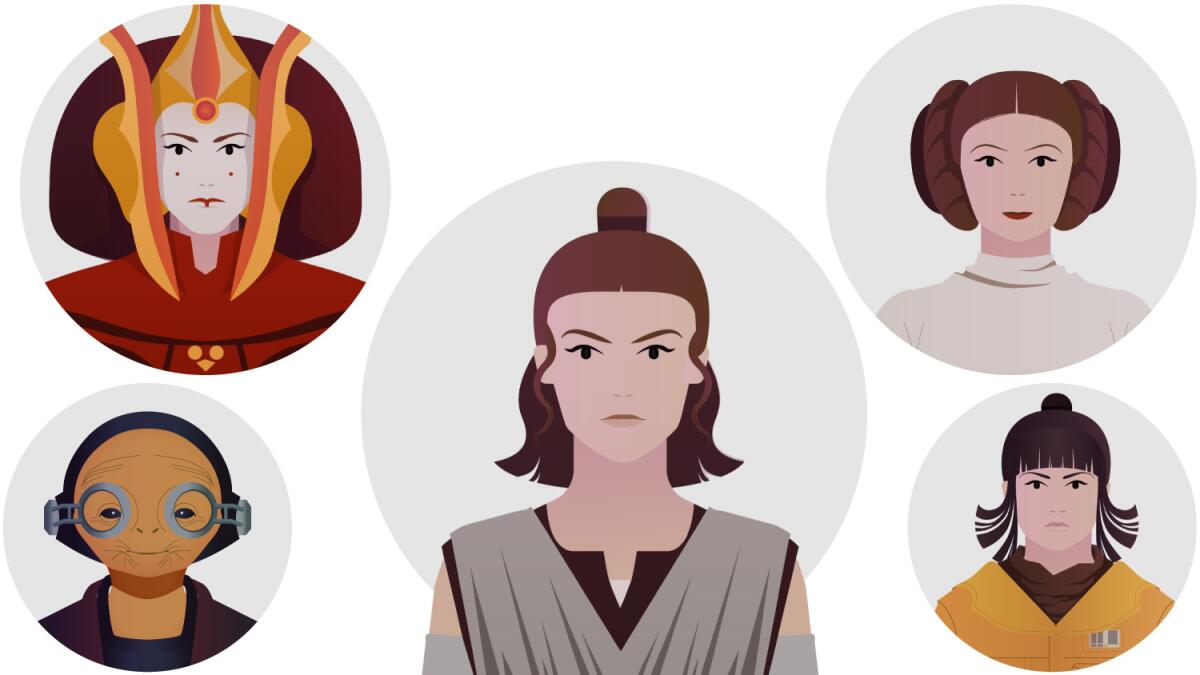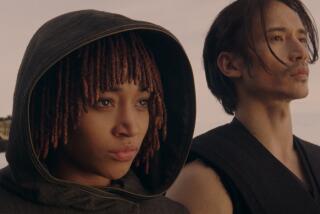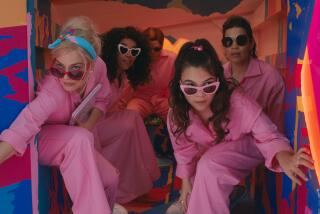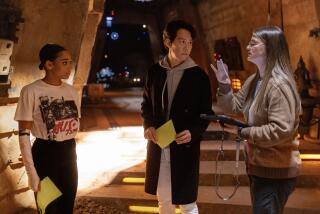We spent over 100 hours studying Star Wars’ female characters. Here’s why we did it

- Share via
With the release of the final chapter of the Skywalker saga, “Star Wars: The Rise of Skywalker” on the horizon, we, the nerds of the Los Angeles Times, set out to make something comprehensive about the eight movies in the Skywalker saga released so far.
We considered a few ideas, but ultimately our team was drawn to Rey, the first female protagonist in a series that had been largely focused on men. In her role as a scavenger-turned-Jedi, Rey seemed like a revolution. We asked ourselves: How far does the representation of women go? How wide was the gender gap in “Star Wars” to begin with? Have Rey and other women actually brought balance to the series? To find out, we had to give the entire series a hard look.
The results of our study, which required over 100 hours re-watching all eight Star Wars movies, were published today.
Portrayed by Daisy Ridley, Rey is the central Force-sensitive protagonist of the “Star Wars” sequel trilogy, whose introduction in 2015’s “The Force Awakens” sparked hope that the franchise was finally moving to reflect the diversity of the real world.
Here’s why we did it.
What was the process like?
The process was surprisingly time-consuming. While we were able to find fan-made scripts for each of the movies, they varied significantly from the latest editions you can stream online.
So we needed to transcribe our own script for each of the eight movies, which have an average 8,500 words of dialogue. Each script would then need to be converted into a spreadsheet recording each line’s speaker, word count and to whom the line was addressed.
We signed up for Disney+ the day it came out, and the three of us each had a movie marathon.
During this process, we had to wrestle with some difficult decisions:
- If Kylo Ren is speaking to a destroyed helmet, is he really communicating with Darth Vader? (We say, “Nope.”)
- If Luke speaks with a Force ghost of Obi-Wan, does it count as words exchanged between the two? (We say, “Yep.”)
- When is it Darth Vader speaking and when is it Anakin Skywalker speaking? Does the difference matter? (We opted to split them up.)
- Who is “important” enough to include? We decided to focus on the top 15 characters listed in the credits, plus a few of our personal favorites.
After many lengthy conversations and some spreadsheet magic, we were able to create a list of all lines of dialogue for the entire series.
We also drew illustrations depicting about 50 characters from Darth Vader to BB-8, and even Jar Jar Binks.
Why did you do this?
Hollywood has been roiled in recent years by a controversy over the limited role that women and minorities have in the industry.
Production companies like Disney have responded by diversifying their offerings at the box office. Few examples are more prominent than the introduction of Daisy Ridley in the role of Rey in the newly rebooted Star Wars franchise.
Our study sought to take a quantitative approach to more closely analyzing one aspect of this change: the scripts.
Did your analysis look at other factors that influence a character’s role in a movie, such as screen time?
No. While our study does not take into account how long characters are on the screen regardless of whether they’re speaking, we believe it captures an important relationship between the characters themselves as well as between the characters and the audience.
What did you find most interesting in your research and why?
Despite being big “Star Wars” fans who have seen the movies many times, once we started carefully counting we were surprised at how much some of the men were speaking. You might expect Luke Skywalker to dominate the script in the original trilogy, but it was actually Han Solo. The difference wasn’t much, but it was there in the data. To our surprise, Poe Dameron was the top speaker in “The Last Jedi.”
Finn, considered by some a supporting character, spoke the most in “The Force Awakens,” making him the first person of color to speak the most in a “Star Wars” film.
We were so fascinated by the final tally that we made a whole other page for it.
Ahead of the release of the final chapter of the “Star Wars” saga, The Times analyzed the dialogue in all eight movies to find out which characters spoke the most.
More to Read
The biggest entertainment stories
Get our big stories about Hollywood, film, television, music, arts, culture and more right in your inbox as soon as they publish.
You may occasionally receive promotional content from the Los Angeles Times.














